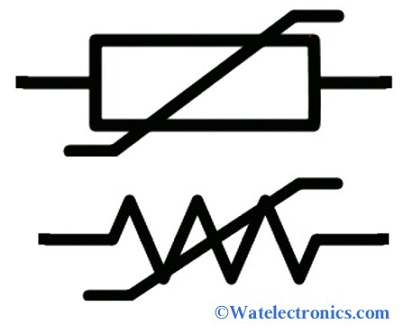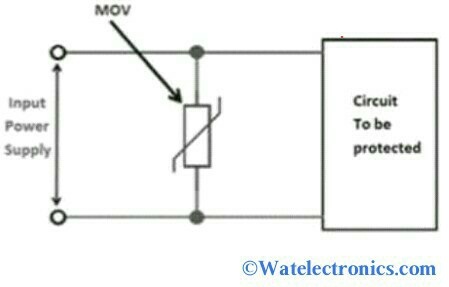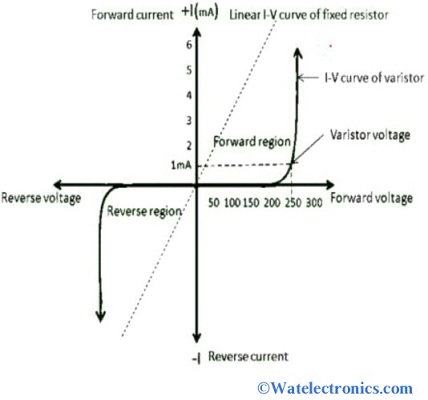A passive two-terminal semiconductor device that is used to protect electronic and electrical circuits is called Varistor. It protects against over-voltage by clamping of voltage. It is also known as a voltage dependant resistor (VDR) or non-linear resistor. The resistance of the varistor is changed due to the change in voltage across it. The varistors are non-ohmic variable resistors with symmetrical current and voltage features applicable for both DC and AC applications. In AC operations, these are connected to either phase-to-phase or phase-to-neutral. While in DC operations, these are connected to positive or negative terminals for DC stabilization to protect the whole electronic circuit against over-voltage. A metal oxide varistor is one of the forms of varistor used in various surge protection applications. This article describes Metal Oxide Varistor (MOV) in detail.
Metal Oxide Varistor – Basics
Definition: The most commonly used form of a varistor is the Metal Oxide Varistor, which is also a voltage dependant and non-linear resistor connected to the electrical and electronic circuits to protect against the switch, lightning surges, and to achieve high suppression of transient voltage.

Metal Oxide Varistor
The MOV is made up of zinc oxides with metal oxides like cobalt, bismuth, and manganese are inserted between the two metal plates, which as two electrodes. The resistance of the MOV can be varied to protect the power supply circuit from spikes due to high voltage. It is always used as a protector in the circuits where the supply is directly taken from AC mains.
The Metal Oxide Varistors contains two electrodes and looks like a capacitor physically. It is connected to any direction because there is no polarity for electrodes like a resistor. To increase the energy handling capability, the MOV is in parallel to the circuit, which is to be protected. While producing the higher voltage ratings to the circuit, it is connected in series. It is mandatory to connect the MOV to protect the circuit from high voltage spikes due to the direct power supply from the mains. The basic symbol of varistor or metal oxide varistor is shown below.
Metal Oxide Varistor Circuit
The MOV is placed between the power supply mains and the circuit to be protected from the high voltage spikes is shown below. The resistance of the MOV is changed automatically based on the Voltage applied to the circuit.

MOV Circuit
From the above figure, the MOV is used in parallel with the circuit, which is to be protected from spikes. The MOV starts working due to the voltage applied across its electrodes and stops working due to the less threshold voltage (applied voltage is below threshold voltage). These types of varistors are available in different forms like disks, axial devices, screw and block devices, and radial devices. Due to the mixture of metal oxides, the MOV is the series combination of more no. of diodes.
Working of Metal Oxide Varistor (MOV)
The working of the Metal Oxide Varistor (MOV) depends on the applied voltage. When the applied voltage is within the specified range, then the MOVa, that is connected parallel to the circuit will have high resistance and no current flows through it. Due to the high resistance of MOV, the current flows through the circuit and works as per the application. When there is any lightning surge or spikes due to the over-voltage in the AC mains, the resistance of the MOV decreases and its value will be low and becomes short.
Due to the high voltage, a large amount of current flows through the MOV that leads to the blowing of the fuse and disconnecting the circuit from the mains. As soon as the voltage spike occurs, the high voltage (over-voltage) returns to its normal values immediately and the circuit performs its normal operation. In such cases, the current flow will not be enough to blow the fuse and the duration of flow is also less.
That means, at every voltage spike, the MOV disconnects the circuit automatically to prevent the damage from the over-voltages. If the MOV is damaged, then we can conclude that the circuit has gone through various voltage spikes.
Clamping Voltage of Metal Oxide Varistor
During the operation, when the circuit is subjected to a high transient voltage pulse, the MOV placed in parallel clamps the voltage level to avoid the spikes and lightning surges. To protect the circuit and its components, the MOV absorbs the potentially destructive energy and protects the circuit from damage. And also MOV will be in a non-conductive state when it connected as a shunt mode device in its normal operation.
Hence the clamping voltage of the metal oxide varistor is the rated voltage measured across it, in terms of DC current of 1mA. That means the varistor allows the 1mA current to flow through it when the DC voltage is applied across it. The varistor works as an insulator until it reaches the rated voltage.
Once the applied voltage reached its rated Voltage, then it starts conducting. When the applied voltage is low, then the reverse leakage current will also be low across the electrodes of MOV. When the applied voltage is high, the avalanche breakdown occurs and the resistance of the MOV will be equal or greater than its rated voltage. The MOV clips off the high voltage spikes and surges occurred due to the sudden high transient voltages and acts as a self-regulator.
MOV Specifications
In order to choose the perfect MOV for the specific application, it is necessary to know its characteristics and specifications. The MOV specifications are
Maximum Varistor Working Voltage
It is referred to as the steady-state DC voltage. Where the leakage current is less than the specific value.
Clamping Voltage
The MOV starts conducting and surge current will be dissipated.
Surge Current
It is referred to as the maximum peak current applied to the device without any damage.
Surge Shift
The decreases in clamping voltage due to the surge. This results in a difference in the voltage called surge shift
Absorption of Energy
The dissipation of maximum energy by the MOV due to the surge for a specific period of time. It is determined by using specific values of the circuit and expressed as transient time vs time taken to reach half the peak value.
Maximum AC Voltage
It is referred to as the maximum RMS line voltage, which is above the actual RMS line voltage. Overlapping of peak voltage with the varistor voltage reduces the lifespan of the components in the circuit.
Leakage Current
It is referred to as the current flowing through the MOV when there is no surge and working below the clamping voltage.
Characteristics
The general characteristics of the MOV are,
- Operating voltage ranges from 18V to 1200V
- Max. of Insulation resistance will be 1000ohms
- Response time will be less than 15ns
- Leakage current will be maximum of 200mirco amps
- Operating and storage temperature should be -40°C to +140°C
- Capable of responding to transient over-voltage
- Capable of absorbing a large amount of transient energy and should have a low clamping ratio.
MOV Performance
The MOV is a type of varistor that acts as a protection component or over-voltage protector of electronic and electrical circuits. It is different from fuse and circuit breakers that from high current. It is a voltage dependant, non-linear, and variable resistor, where the resistance changes automatically based on the power supply voltage coming from the mains.

MOV Performance
The MOV follows the clamping voltage method and its V-I characteristics are non-linear and are similar to the Zener diode. The voltage-current characteristics are linear when the MOV is in a non-conducting state. This is because the resistance of the MOV will be low and remains stable.
As soon as the voltage spikes, the resistance of the MOV increases automatically and disconnects the circuit from the mains and it is protected from the induced lightning surges and high voltage spikes. The main advantage of the MOV is, it can work in both forward bias and reverse bias conditions. The V-I characteristics of the MOV are similar to the basic varistor shown below.
Metal Oxide Varistor Applications
The Metal Oxide Varistor applications are,
- Used in the protection of diodes, ICs, transistors, thyristors or Triac semiconductors
- Used in consumer electronics, industrial electronics, communication electronics, measuring and controlling systems for surge protection
- Used in electronic home appliances, petroleum, and gas for surge protection
- Used in relays and the electromagnetic valve surge absorption
- Used to suppress surges caused due to the switching of inductive loads like relays, coils, and transformers.
- Used to protect against surges caused by lightning strikes incoming power lines.
- Used to protect overvoltages, voltage spikes, line to line, switching, and arching.
Please refer to this link to know more about Clamp Meter & Surge Protector.
Thus, this is all about the Metal Oxide Varistor (MOV) – basics, circuit, working, clamping voltage, performance, and applications. Here is a question for you, “What is the resistance of MOV?”